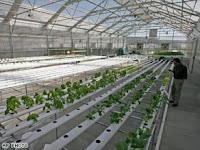Hydroponics in the City
>> Saturday, November 22, 2008
The frontier of agriculture is the urban setting. This trend is borne out of necessity for economic reasons and environmental reasons as well as for our health. Apartment buildings, rooftops, and vacant lots across the country are becoming important avenues of bringing fresh fruit and vegetables to those who otherwise have very limited access.
 This photo is of an operation at the California State Polytechnic University, where the future of hydroponics – a method of cultivating plants in water instead of soil – is getting a second look as a viable option to bring farming into cities, where consumers are concentrated.
This photo is of an operation at the California State Polytechnic University, where the future of hydroponics – a method of cultivating plants in water instead of soil – is getting a second look as a viable option to bring farming into cities, where consumers are concentrated.
Most of the reasons for establishing urban hydroponic farms are already known to us:
to lessen the environmental cost of shipping produce from farms to cities (the routes some foods take to reach your table is extremely wasteful and downright ridiculous)
to slow down the loss of wilderness for farmland
help control the risk of bacteria along extensive, insecure food chains (we have all read horrific tales of recalled food due to contamination)
brings food closer to inner-city areas where fresh food is less available
to help feed an ever-growing world population
Hydroponics has benefited from nearly three decades of NASA research aimed at sustaining astronauts in places with even less green space than a typical U.S. city so we are gaining a lot of knowledge on the subject. Some cities are putting that knowledge into action.
In a New York City schools program run by Cornell University, students grow lettuce on a school roof and sell it for $1.50 a head to the Gristedes chain of supermarkets. Cornell agriculturist Philson Warner, who designed the program's hydroponics system, said his students harvest hundreds of heads of lettuce a week from an area smaller than five standard parking spaces by using a special nutrient-rich solution instead of water.
The numbers have some researchers imagining a future when enough produce to feed entire cities is grown in multistory buildings sandwiched between office towers and other structures.
Columbia University environmental health science professor Dickson Despommier, who champions the concept under the banner of his Vertical Farm Project, said he has been consulting with officials in China and the Middle East who are considering multistory indoor farms.
Hydroponics is universally recognized as a sustainable production method and it has a strong reputation for high quality, “clean, green” produce. Russia, France, Canada, South Africa, Holland, Japan, Australia, and Germany are among other countries where hydroponics is receiving attention.
However, the expense of setting up the high-tech farms on pricey city land and providing enough year-round heat and light could present some insurmountable obstacles. Also, the systems commonly in place today, such as HID lights (high intensity discharge), are extremely inefficient.
Currently, hydroponics is used for relatively few food crops, such as tomatoes, peppers, herbs, cucumbers and lettuce. Tree fruits do not lend themselves to hydroponics. Most vegetables are cheaper to grow in soil as are grains, beans and potatoes.
There are alternatives to hydroponics: ProMedica Health System network of Ohio, used a Toledo hospital roof to grow more than 200 pounds of vegetables in stacked buckets filled with a ground coconut shell potting medium. The tomatoes, peppers, green beans and leafy greens were served to patients and donated to a nearby food shelter. When the project resumes in the spring, the hospital plans to expand into at least two community centers in economically depressed central Toledo, where fresh produce is hard to come by.
As our population grows, and land and water become more scarce, and we reject the obscene expense of raising animals for food (along with all the associated health and environmental dangers), we are going to rely more on urban agriculture to help feed us. Whether hydroponics will become the most viable option remains to be seen. But there is no doubt that urban agriculture is a growing trend.
Further reading:
Urban Agriculture
Urban Agriculture and Community Gardening
Center for Urban Agriculture
Dangers of Meat Consumption
Meat Alternatives
Urban Gardening Help








0 comments:
Post a Comment